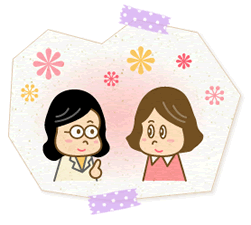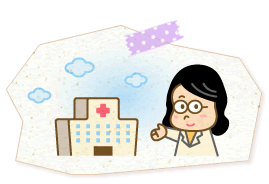
Q11.For some time after giving birth, many women seem to suffer from urinary problems, sore private parts, and sex life problems. Are these caused by illness?
After giving birth, women tend to suffer from urinary incontinence for a few months due to loss of muscular control in their vagina. However, this will be alleviated as time passes. This process is called pelvic floor** recovery. The time required for recovery and the extent of natural recovery depend upon the woman’s age, as well as her physical condition. Pelvic floor muscle exercises after childbirth are effective for promoting pelvic floor recovery.
The difference between women who are bothered by urinary incontinence and those who are not, is related to such factors as: urinary continence capacity (to hold urine in the bladder) before pregnancy, urinary habits during pregnancy and after delivery, and whether delivery was easy or difficult. Problems, including minor ones such as urinary incontinence and loose vaginas during pregnancy and perinatal periods, happen to almost all women after childbirth. As long as recovery is progressing at an appropriate speed for one’s age, there is no need to consider these changes as signs of illness. However, if the pelvic floor does not recover to the pre-pregnant state because of injuries from a difficult delivery, or the process of your natural recovery from severe urinary incontinence hit a plateau, then
additional medical attention is necessary.
(Note) “pelvic floor”:
The pelvic floor, made of strong fibrous tissue and muscles, is the bottom part of the pelvis that supports organs in the pelvis such as the bladder, uterus, and rectum.
Q12.What causes post-delivery urinary incontinence?
The main cause is that the uterus changes in size by expanding during pregnancy and later contracting after childbirth. During pregnancy, the enlarged uterus places pressure on the bladder. In addition, the smooth muscles*** in the body, including those of the bladder, relax under the influence of hormones. The bladder is compressed between the uterus and the pubis, thereby stretching the bladder wall disproportionately when compared to the contained volume of the bladder. 
After delivery, the uterus contracts rapidly, eliminating any compression to the bladder. However, the bladder wall can not regain its original tension and the wall is left sagging for a while. During this period, the urge to urinate (a sense of “I have gotta go”) gets weak. And the bladder muscles have to contract strongly for urination when the uterus undergoes involution. It may be hard to urinate after child-bearing at an advanced age or a difficult delivery, as the bladder can not contract properly for a while.
The second main cause of post-delivery urinary incontinence is that the pelvic floor stretches greatly to sustain injuries when the baby passes out of the uterus at birth. For a while after delivery, the vaginal passage is somewhat loose, and the bladder and urethra may be compressed into your vagina or move upward or downward with abdominal pressure. Muscles and supporting tissue of the pelvic floor may tear during prolonged labor if your baby is pressed straight down through your uterus or pulled with forceps or a suction device.
In addition, bladder atony can occur due to reduced functioning of nerves controlling the bladder or urethra when delivery stops midway for more than half-a-day. A remarkable case of bladder atony causes difficulty in urinating, not urinary incontinence. However, latent voiding dysfunction occurs frequently, developing into stress urinary incontinence. In fact, women suffering from stress urinary incontinence often squeeze and force out their urine with abdominal pressure because their bladder is unable to contract enough during urination. Latent voiding dysfunction, as explained above, is due to the reduced functioning of the nerves and a relaxed bladder wall.
(Note) “The smooth muscle”:
The smooth muscle is a kind of muscle composed of blood vessels and organs and controlled by autonomic nerves and hormones. Its contractions are involuntary.
PAGE TOP
Q13.How can women cope with urinary incontinence after childbirth?
If daily life is hindered by urinary incontinence even after lochia disappears, for the time being use an incontinence pad. It is better to use a pad exclusively made for urinary incontinence instead of a sanitary pad or a panty liner. Sanitary pads are designed to be used only a few days per month to absorb blood. Whereas, incontinence pads are designed to be used continuously on a daily basis and are highly absorbent, allowing heat and moisture to evaporate and decreasing the occurrence of rash in the private parts.
Women who suffer from urinary incontinence will always worry about urinating. Some women will frequently go to the toilet, without the urge to urinate, and try to force out the urine with abdominal pressure. However, doing so repeatedly will only prolong this condition. To prevent the risk of worsening stress urinary incontinence, avoid early and forced urination. In several months after childbirth the urge to urinate and bladder contractions will improve and get stronger. When worrying about urinary incontinence, use incontinence pads and avoid frequent, short-time interval urination.
Pelvic floor muscle exercises do not always have to start immediately after childbirth. For a few days just after delivery, inflammation in the muscles and supporting tissue of the pelvic floor will still remain. For example, would you start a workout on the very next day after you pulled a muscle or sprained some part of your body while playing sports? You would not – certainly not. Pelvic floor muscle exercises can be started when you can tighten your pelvic muscles with confidence and you do not feel any sense of discomfort or any pain in doing so. Please ask your midwife or gynecologist to see whether or not you are using the correct muscles. You should start your exercises after learning the basic points from your midwife.
There is also a training method to stop urinating midway by firmly tightening pelvic floor muscles, however, disrupting the normal urinary reflex is extremely harmful to one’s health. Therefore, this method can not be recommended from a medical point of view. To reduce urinary incontinence in women after giving birth, emphasis should not only be placed on building up the pelvic floor, but also on the coordinated functions between the bladder and urethra.
PAGE TOP
Q14.After giving birth, how long does urinary incontinence last? When is the right time to see a doctor?
The bladder and urethra of childbearing-aged women usually have enough reserve strength that the urge to urinate and force of urine discharge will recover gradually over time. However, due to failure to develop adequate leg muscles while growing up, nowadays problems with the pelvic floor during pregnancy and after childbirth are a matter of concern. These problems are more common in women who have children later in life.
In the past, most of those suffering from urinary incontinence needed about one month before improvements could be witnessed. However, it takes about two months for a woman who has had her first baby at around age 40 to regain full recovery of the pelvic floor.
In any case, if urinary incontinence hinders your daily life, you should inform your doctor during the one-month check-up after childbirth. He or she will be able to monitor your condition for such problems as uterine or vaginal prolapse.
If urinary incontinence does not inconvenience your daily life, you can wait a while and see how your condition progresses without consulting your doctor. Whether or not treatment and management of uterine or vaginal prolapse is needed is judged on a case-by-case basis.
When you can not see much improvement in your urinary incontinence in three to four months after giving birth, in such cases we have learned from statistics that natural healing has hit a plateau and that this condition has become permanent. This is the right time to see your doctor, even though your daily life is not inconvenienced.
If you are planning to return to work, you may be concerned about your condition after your maternity leave is over. In most cases, you will need to find a specialized facility for treatment. However, before doing so, it would be a good idea to obtain a referral letter that contains information about the progress of your pregnancy and childbirth conditions from the facility where you gave birth.
Q15.Sometimes a woman’s body sustains damage on various private parts from giving birth, even though there are no external symptoms of such damage. What should young women who will go through pregnancy and delivery in the future keep in mind to avoid problems in their private parts after delivery?
1. 1 Strengthening muscles by using your legs
The adult skeleton and muscles are formed from the second growth period to the mid-twenties. Strong legs and a pelvic floor cannot be developed unless you have enough opportunities to build up your legs from puberty to your mid-twenties when the pelvic floor is being formed. People today use vehicles to get to wherever they need to go, thereby decreasing the use of their legs to walk, which is a problem. I am also concerned that many women go on excessive diets in their teens or wear high-heeled shoes that cause imbalanced use of their hips and legs.
There are many middle-aged and elderly people interested in pelvic floor muscle and abdominal muscle exercises. However, there is a saying: “The health of your pelvic floor comes first from your healthy legs.” You should use your legs and hips thoroughly and walk on your legs by kicking the ground. In addition, you can try to maintain your muscles by means of sports, workouts, and pelvic floor exercises. This is the most recommended approach. If your pelvic floor muscles function properly, you can strengthen them by using your hip and legs.
2. Controlling your weight
Excess weight may increase problems in your joints, as well as the pelvic floor. When you can not move your legs smoothly due to pain in your knees and hips while walking, every step will put excess strain on your pelvic floor. Increase in fat around your inner organs will increase your inner physical pressure, which will press down on your bladder and pelvic floor to cause an urge to urinate and urinary incontinence. Then, what is your ideal weight? It is often said that by taking into account the body build and type, you should return to your body weight in your mid-twenties when the structure of your body was completed. However, there are some exceptions to this.
3. Factors causing pelvic floor strain
When you visit the orthopedics department of a hospital or clinic due to a lower backache, you may have an orthopedic corset made for you. It is effective in the management of an acute lower backache, but coughing, sneezing and straining which increase abdominal pressure will have a full-scale impact on the pelvic floor. That is because the force can not be diverted to the front or side of the stomach due to the orthopedic corset around your waist. Therefore, some people suffer from uterus prolapse or urinary incontinence due to wearing a corset. The corset around your waist will increase the burden on your pelvic floor, so it may have harmful effects if you keep wearing it as a precaution at your own discretion. You should wear it only during the period prescribed by your orthopedic doctor.
Other factors that might increase the burden on your pelvic floor are as follows: always straining due to constipation and always coughing and sneezing due to bronchial asthma, respiratory tract allergy and others. Depending upon the degree of seriousness, treatment for constipation, coughing and sneezing should be received to protect your pelvic floor.







